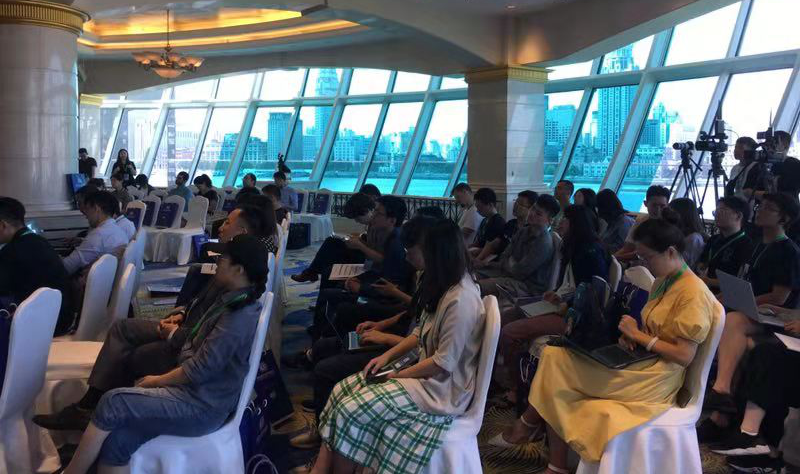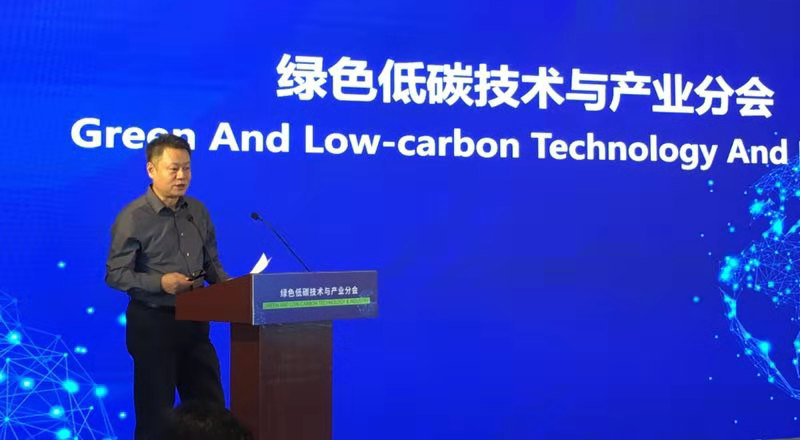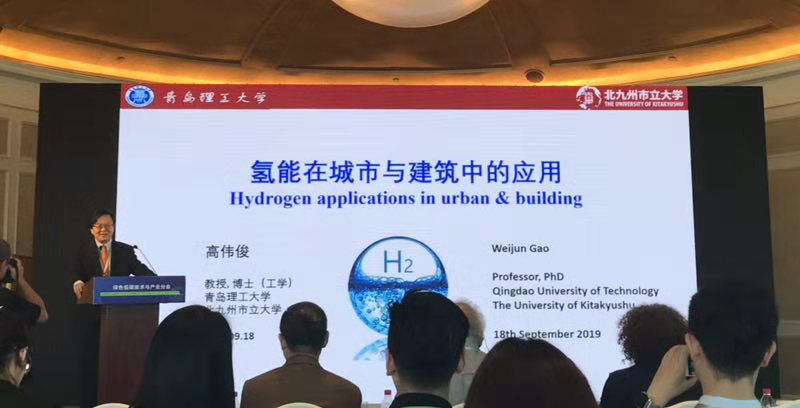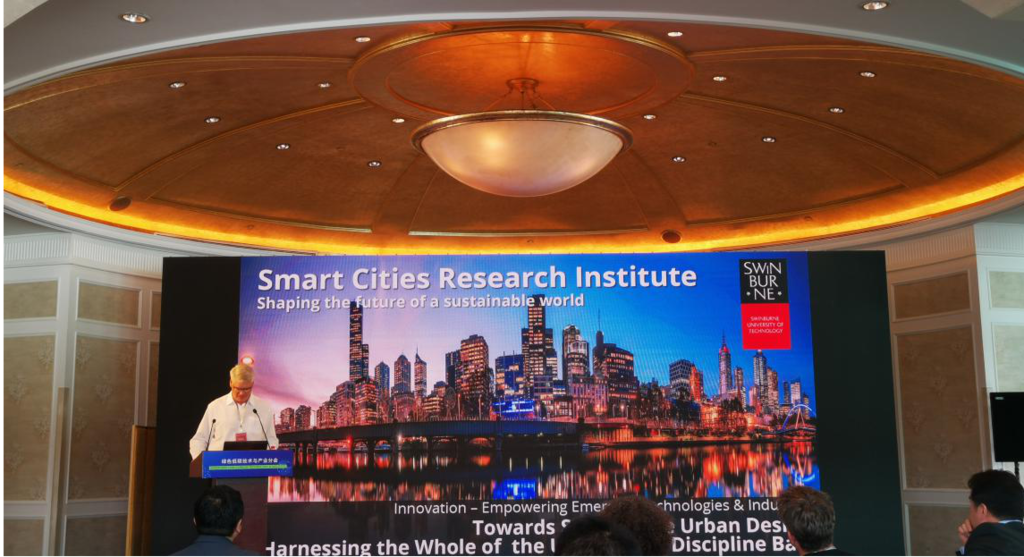On September 18, 2019, the International Conference on IEID Innovation and Emerging Industries Development, co-sponsored by the Chinese Academy of Engineering, the Shanghai Municipal People's Government, the Ministry of Industry and Information Technology and the International Knowledge Center for Engineering Sciences and Technology (IKCEST) under the auspices of UNESCO and Tongji University, was successfully held in 5F Europe, Shanghai International Conference Center.

With the theme of "Green Intelligence", the forum explores how AI technology can improve the built environment performance, adaptability and resource utilization efficiency, improving the quality of human life, reducing the impact of environmental degradation and global warming by means of computational algorithms, digital twins and intelligent construction. This sub-forum covers new materials, energy, ecology, cities, green buildings and other related industries. World-renowned entrepreneurs, industry leaders, academicians, University experts and scholars, through a new perspective of artificial intelligence technology and philosophy, explore how to enable green low-carbon development. The conference is devoted to sharing the frontiers of "Green Intelligence" and its scientific and technological achievements, exploring the way of sustainable development, leading the future development of science and technology, promoting national innovation-driven development, and ultimately achieving the healthy and sustainable development of human living environment.
The meeting was addressed by Professor Sun Tongyu, Vice Dean of School of Architecture and Urban Planning, Tongji University. First of all, he thanked the sponsor, the Chinese Academy of Engineering, the Shanghai Municipal People's Government, the Ministry of Industry and Information Technology, and the Tongji University and the International Engineering Science and Technology Knowledge Center for organizing this academic event. He then welcomed the eight well-known scholars from afar and the audience, and expressed his support and expectation for the successful holding of the Green Low Carbon Technology and Industry Branch.

Professor Gao Weijun, the academician of Japanese Academy of Engineering and the director of Qingdao Polytechnic University, first gave an academic report entitled Application of Hydrogen Energy in Cities and Architecture. Professor Gao revealed to us the mechanism of high-efficiency hydrogen production from renewable energy and its wide application in cities through the application research of regional energy structure prediction model construction, the analysis of efficient hydrogen production means from renewable energy generation, the structure study of synergistic electricity-hydrogen energy system, and the operation and management mode of high-efficiency urban application.

Subsequently, Professor Niu Jianlei introduced how the development of computer directly promoted the development of simulation tools and acted on the prediction and design of urban micro-environment based on the increasingly serious reality of heat island effect and the rich practical cases of his team, thus promoting the realization of some innovative and practical design concepts.
After Professor Niu's wonderful speech, Professor Sun Tongyu discussed the energy utilization in the field of architecture with Professor Gao Weijun, Professor Phil Jones and Professor Renata Sentkiewicz. In addition, they also launched brilliant discussions on many hot topics, such as energy storage, hydrogen energy promotion and application, zero energy consumption building development prospects and so on.
Philip Jones, an expert on energy-saving, low-carbon and sustainable design of built environment, referred to design and research cases in Europe and other parts of the world in his report entitled Building with Zero Carbon and Positive Energy Consumption, and explored the role of building as an indispensable part of our future energy system.
In the first half, Renata Sentkiewicz, partner of Abalos+Sentkiewicz AS+Firm, shared a report entitled Thermodynamic Architecture Beyond Sustainability Ranking System. Renata said that as practitioners, public space should not be sacrificed as a condition of energy balance within the building. The lecture combines three practical cases of different scales and locations, such as Azuqueca de Henares Leisure Center, to show the audience how to meet the relationship between building form/material/energy flow through parametric design tools and basic thermodynamic principles in the light of local cultural conditions.

After lunch break, the forum entered the second half of the agenda, which was chaired by Professor Yuan Feng from the School of Architecture and Urban Planning, Tongji University. Professor Yuan Feng first expressed his great honor to be able to use this platform to invite eight excellent speakers. He mentioned that China, Shanghai and Tongji are all places with abundant talents and open compatibility. He hopes to have more in-depth academic exchanges and cooperation with the guests in the future.
As an academician of the European Academy of Sciences and a professor of Tongji University, Neil Leach explored the application of 3D printing structure on the Moon from two different research projects based on the practice of "in-situ sampling" in space exploration.
Later, David Malott, CEO and creative director of AI Space Factory, shared how humans starts from Mars to Earth. He first analyzed with the audience the serious environmental problems facing the Earth and the similarities and differences between the Martian environment on Earth, and proposed the construction of the Martian globalization. Subsequently, based on the analysis of renewable energy and construction technology and the sharing of several 3D printing research projects on Mars'future human settlements, he expressed the broad application prospects of construction technology applied to Mars.

Professor Bob Sheil, Dean of UCL School of Architecture, shared New Forms of Practice in conjunction with UCL's works currently on display. He said researchers should break through disciplinary barriers and deal with difficult environmental challenges from a multi-perspective. He shared UCL's recent exhibition "Machine Incremental Molding Crafts" in London. Among them, there are works exploring the paradigm of form based on environmental performance and biological materials - this is also a typical interactive design involving objects, space, people and systems. In addition, he introduced his newly published Drivers of Change. The book focuses on global construction environment issues and proposes pioneering solutions for the future.
Finally, Professor Mark Burry, Academician of the Australian Academy of Engineering, Sweet University of Technology, shared the exciting content related to Smart City. Professor for the smart city, proposed the participation of the whole people in future urban decision-making, future urban mobility, future residential space and other smart city-related design strategies. Through many cases of practical projects and academic research, he vividly and interestingly shared the problems and challenges he encountered in the process of practical research.

After the guest speech in the afternoon, Professor Yuan Feng chaired the round table in the second half. Professor Yuan Feng and Professors Neil Leach, David Malott, Bob Sheil, Mark Burry and Renata Sentkiewicz discussed the redefinition of architect identity, the prospects of practice, the curriculum structure and knowledge sharing system of architecture education in the digital age.
At the end of the seminar, Professor Yuan Feng once again expressed his gratitude to the eight distinguished guests and participants. He pointed out that the conference was a very unique one in the field of digital construction in China. By inviting experts from all over the world to share their advanced and innovative ideas, a good international academic communication platform was established. He then announced the successful conclusion of the seminar.
Original Text (This is the original text for your reference.)
On September 18, 2019, the International Conference on IEID Innovation and Emerging Industries Development, co-sponsored by the Chinese Academy of Engineering, the Shanghai Municipal People's Government, the Ministry of Industry and Information Technology and the International Knowledge Center for Engineering Sciences and Technology (IKCEST) under the auspices of UNESCO and Tongji University, was successfully held in 5F Europe, Shanghai International Conference Center.

With the theme of "Green Intelligence", the forum explores how AI technology can improve the built environment performance, adaptability and resource utilization efficiency, improving the quality of human life, reducing the impact of environmental degradation and global warming by means of computational algorithms, digital twins and intelligent construction. This sub-forum covers new materials, energy, ecology, cities, green buildings and other related industries. World-renowned entrepreneurs, industry leaders, academicians, University experts and scholars, through a new perspective of artificial intelligence technology and philosophy, explore how to enable green low-carbon development. The conference is devoted to sharing the frontiers of "Green Intelligence" and its scientific and technological achievements, exploring the way of sustainable development, leading the future development of science and technology, promoting national innovation-driven development, and ultimately achieving the healthy and sustainable development of human living environment.
The meeting was addressed by Professor Sun Tongyu, Vice Dean of School of Architecture and Urban Planning, Tongji University. First of all, he thanked the sponsor, the Chinese Academy of Engineering, the Shanghai Municipal People's Government, the Ministry of Industry and Information Technology, and the Tongji University and the International Engineering Science and Technology Knowledge Center for organizing this academic event. He then welcomed the eight well-known scholars from afar and the audience, and expressed his support and expectation for the successful holding of the Green Low Carbon Technology and Industry Branch.

Professor Gao Weijun, the academician of Japanese Academy of Engineering and the director of Qingdao Polytechnic University, first gave an academic report entitled Application of Hydrogen Energy in Cities and Architecture. Professor Gao revealed to us the mechanism of high-efficiency hydrogen production from renewable energy and its wide application in cities through the application research of regional energy structure prediction model construction, the analysis of efficient hydrogen production means from renewable energy generation, the structure study of synergistic electricity-hydrogen energy system, and the operation and management mode of high-efficiency urban application.

Subsequently, Professor Niu Jianlei introduced how the development of computer directly promoted the development of simulation tools and acted on the prediction and design of urban micro-environment based on the increasingly serious reality of heat island effect and the rich practical cases of his team, thus promoting the realization of some innovative and practical design concepts.
After Professor Niu's wonderful speech, Professor Sun Tongyu discussed the energy utilization in the field of architecture with Professor Gao Weijun, Professor Phil Jones and Professor Renata Sentkiewicz. In addition, they also launched brilliant discussions on many hot topics, such as energy storage, hydrogen energy promotion and application, zero energy consumption building development prospects and so on.
Philip Jones, an expert on energy-saving, low-carbon and sustainable design of built environment, referred to design and research cases in Europe and other parts of the world in his report entitled Building with Zero Carbon and Positive Energy Consumption, and explored the role of building as an indispensable part of our future energy system.
In the first half, Renata Sentkiewicz, partner of Abalos+Sentkiewicz AS+Firm, shared a report entitled Thermodynamic Architecture Beyond Sustainability Ranking System. Renata said that as practitioners, public space should not be sacrificed as a condition of energy balance within the building. The lecture combines three practical cases of different scales and locations, such as Azuqueca de Henares Leisure Center, to show the audience how to meet the relationship between building form/material/energy flow through parametric design tools and basic thermodynamic principles in the light of local cultural conditions.

After lunch break, the forum entered the second half of the agenda, which was chaired by Professor Yuan Feng from the School of Architecture and Urban Planning, Tongji University. Professor Yuan Feng first expressed his great honor to be able to use this platform to invite eight excellent speakers. He mentioned that China, Shanghai and Tongji are all places with abundant talents and open compatibility. He hopes to have more in-depth academic exchanges and cooperation with the guests in the future.
As an academician of the European Academy of Sciences and a professor of Tongji University, Neil Leach explored the application of 3D printing structure on the Moon from two different research projects based on the practice of "in-situ sampling" in space exploration.
Later, David Malott, CEO and creative director of AI Space Factory, shared how humans starts from Mars to Earth. He first analyzed with the audience the serious environmental problems facing the Earth and the similarities and differences between the Martian environment on Earth, and proposed the construction of the Martian globalization. Subsequently, based on the analysis of renewable energy and construction technology and the sharing of several 3D printing research projects on Mars'future human settlements, he expressed the broad application prospects of construction technology applied to Mars.

Professor Bob Sheil, Dean of UCL School of Architecture, shared New Forms of Practice in conjunction with UCL's works currently on display. He said researchers should break through disciplinary barriers and deal with difficult environmental challenges from a multi-perspective. He shared UCL's recent exhibition "Machine Incremental Molding Crafts" in London. Among them, there are works exploring the paradigm of form based on environmental performance and biological materials - this is also a typical interactive design involving objects, space, people and systems. In addition, he introduced his newly published Drivers of Change. The book focuses on global construction environment issues and proposes pioneering solutions for the future.
Finally, Professor Mark Burry, Academician of the Australian Academy of Engineering, Sweet University of Technology, shared the exciting content related to Smart City. Professor for the smart city, proposed the participation of the whole people in future urban decision-making, future urban mobility, future residential space and other smart city-related design strategies. Through many cases of practical projects and academic research, he vividly and interestingly shared the problems and challenges he encountered in the process of practical research.

After the guest speech in the afternoon, Professor Yuan Feng chaired the round table in the second half. Professor Yuan Feng and Professors Neil Leach, David Malott, Bob Sheil, Mark Burry and Renata Sentkiewicz discussed the redefinition of architect identity, the prospects of practice, the curriculum structure and knowledge sharing system of architecture education in the digital age.
At the end of the seminar, Professor Yuan Feng once again expressed his gratitude to the eight distinguished guests and participants. He pointed out that the conference was a very unique one in the field of digital construction in China. By inviting experts from all over the world to share their advanced and innovative ideas, a good international academic communication platform was established. He then announced the successful conclusion of the seminar.














 User Center
User Center My Training Class
My Training Class Feedback
Feedback












Comments
Something to say?
Login or Sign up for free